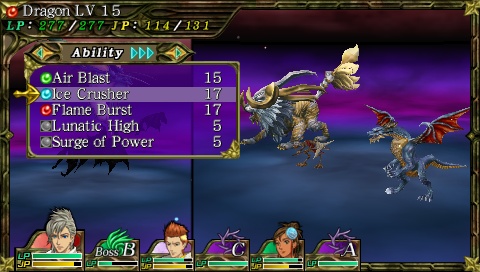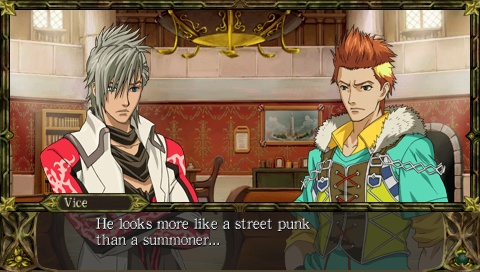Monster Kingdom: Jewel Summoner is a slightly darker take on the collectible-creature formula made popular by the Pokémon games. But while the monsters are a bit more imposing and the characters are a bit less clothed, Jewel Summoner certainly isn't mature in any sense. It's a bland role-playing game wrapped around a compelling, if unoriginal, creature-collection system. The greatest shortcoming of Jewel Summoner isn't its dull story, dearth of character, or lifeless world. Rather, the most nagging issue is the extremely slow progression of the game and a very poor action-to-dialogue ratio. If you can forgive those problems, you'll find several hours of passable entertainment in Jewel Summoner.

In a time long forgotten, humans and monsters peacefully coexisted in the world. But then The Great Disaster came along and turned all of the world's monsters into jewels for some reason. The jewels became a source of power, which was harnessed by the humans to build a great and powerful civilization. Fast-forward many years later, and all of a sudden, monsters known as "abominations" have started to appear and attack people. A young, mysterious man named Vice sets out to defeat the abomination that killed his mother, only to find that he has hidden powers that assign him a much greater destiny. Could it be that Vice is meant to save the world?
Vice is a jewel summoner, a special kind of warrior able to summon monsters from the jewels left behind after The Great Disaster. There is a special group of these warriors known as The Order, and they go around the world using their powers to help people in need. Early in the game Vice joins up with The Order and picks a couple of companion summoners who accompany him for the rest of the game. You and your party of three get assigned missions from The Order. Most of these missions require you to travel to a dungeon, fight your way through some twisting, confusing corridors, and eventually kill the abomination that is causing all the trouble. But you'll visit the same couple of dungeons multiple times, which makes the game feel more like work than an adventure. Compounding the tedium is the unnecessarily lengthy and dull dialogue that you have to sit through before you set out on each mission. It's extremely annoying to be forced to listen to several long conversations when you just want to get down to business and start killing monsters.
Whenever you're in a dungeon you'll often be drawn into random battles. Instead of fighting these battles out with fists or weapons in the traditional sense, each of your characters summons a creature to do the fighting. You can equip up to three monster jewels per character, effectively giving you access to nine monsters in any given battle. The battles are turn-based, and you control your monsters directly. Each monster initially has four slots to which you can assign abilities. There are normal physical attacks, but the most common abilities involve elemental magic. Every monster in the game is assigned to one of eight elements, and by using your knowledge of the relationship between elements you can exploit your enemies' weaknesses. You can also use elemental prisms to capture enemy monsters to use as your own.
There are more than 100 monsters to collect in the game, so you have a lot of options when deciding how to set up your battle party. The monsters you use in battle gain experience, level up, and learn new abilities. That means that you'll probably end up developing a small handful of monsters for fighting, while collecting the rest just for the sake of filling out your monster compendium. In addition to the basic training monsters receive in battle, you can teach them other abilities and even get them to evolve and take on more powerful forms. This is accomplished through the needlessly complicated process of amalgamy. You can collect or purchase special items and different bits of quartz that you can take along with your monster jewels to a jewel meister, who will imbue your monsters with new powers and stat boosts. Do this enough times, and eventually your monster will evolve based on the element of the quartz you have fused with your monster jewel. It's an annoying, convoluted process, but you'll need to use it if you want to collect all of the monsters in the game.
You need more than one superpowered monster, though, because each monster can be used only a few times before it runs out of jewel points. Each action a monster performs costs jewel points, and when they run out, the monster disappears and the next monster you have equipped is automatically summoned. The most powerful abilities can be quite expensive, so even if you do spend the time to develop a specific monster, you'll need to have a couple of second- and third-string monsters on hand. Save points and certain items will replenish the jewel points of your monsters, but you'll still end up having to swap monsters once in a while.
Aside from the amalgamy, the monster collecting and rearing system in Jewel Summoner is at least mildly compelling. The monsters themselves feature nice designs that look and feel unique. You can command everything from caterpillars to thunder golems, and because each one has different elemental abilities they can all be useful if you're willing to put the time in to develop them. Eventually you'll begin to encounter the same monsters over and over, which puts a damper on the collection aspect of the game. It also feels a bit lazy that there are several different elemental versions of the same creature, so you'll end up with three or four turtles that look identical in everything but the color of their shells. They do at least come with different abilities.
If you can't be bothered to collect all the creatures in the game, you can connect with a friend via an ad hoc network and trade monsters. You can also pit your monsters against your friend's in a simple two-player battle mode. There's not much to the multiplayer in Jewel Summoner, but it's an appealing feature for those who are fanatical about collecting things and showing them off to friends.

Jewel Summoner features a lot of colorful still artwork that appears in the backgrounds of towns and other locations. Unfortunately, the towns themselves are nothing more than a series of dots on the screen, most of which seem to be completely pointless because most of the places you visit have nothing to offer beyond a stilted conversation with a generic non-player character. The dungeons are mostly dull and gray with very little in the way of landmarks or distinguishing features, which makes it very easy to get lost. The main characters all have large, nicely drawn portraits that appear onscreen during the dialogue sequences, which look good but unfortunately take a couple of seconds to load each time they appear--so natural transitions are just about impossible in all of the conversations. The same goes for the voices, which are a bit flat to begin with but also take a moment to load before each line. As a result, the conversations sound disjointed. If you appreciate fully voiced dialogue you'll like that there's plenty in this game; it's just a shame that the writing and delivery are so stiff. The music consists mostly of soft ambient tunes in the dungeons, plus a generic up-tempo track that plays during battles.
Monster Kingdom: Jewel Summoner is built on a solid concept that is enjoyable at times, but the rest of the game just feels underdeveloped. With a better story, a world that you can actually explore, and more variety to the dungeons and quests, this could have been a good role-playing game. As it is, it's a very slow game that you'll get tired of long before you finish it.